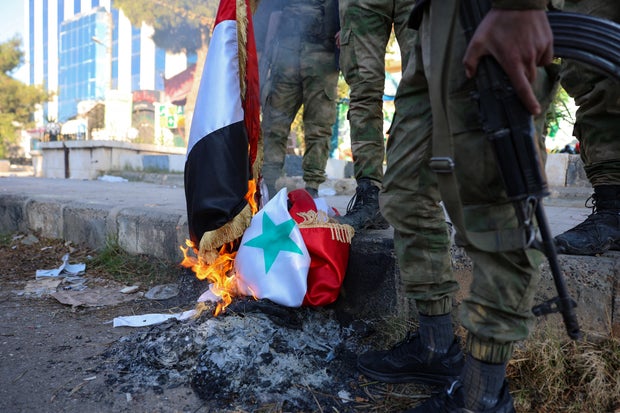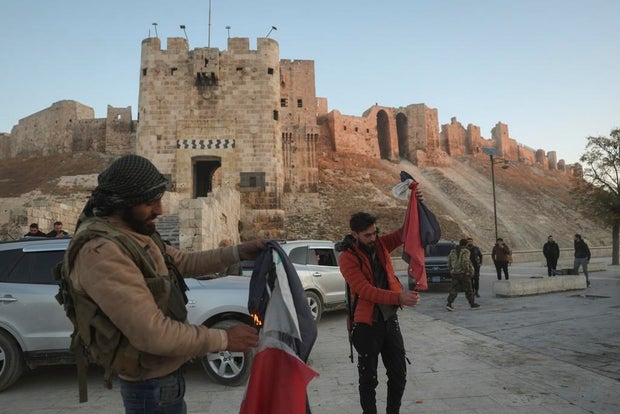Thousands of Syrian rebels took over most of Aleppo on Saturday, establishing positions in the country’s largest city and controlling the airport before expanding their shock offensive into a nearby province. According to fighters and activists, they encountered little to no resistance from government forces.
A war monitor, the Syrian Observatory for Human Rights, said insurgents led by Hayat Tahrir al-Sham took control of Aleppo International Airport, the first international airport controlled by insurgents. The fighters claimed they had captured the airport and posted photos from there.
Ghaith Alsayed / AP
Thousands of fighters also moved on, virtually unopposed by government forces, to seize towns and villages in northern Hama, a province where they had a presence before being expelled by government forces in 2016. They claimed to have invaded the city of Hama on Saturday evening. Hama.
Assad’s forces were taken by surprise
The rapid and surprise offensive is a huge shame Syrian President Bashar Assad and raises questions about the preparedness of its armed forces. The insurgents’ offensive, launched from their stronghold in the country’s northwest, appeared to have been planned for years. It also comes at a time when Assad’s allies have been preoccupied with their own conflicts.
In his first public comments since the offensive began, released Saturday evening by the state news agency, Assad said Syria “will continue to defend its stability and territorial integrity against terrorists and their supporters.” He added that Syria is capable of defeating them no matter how fierce their attacks become.
Turkey, a key backer of Syrian opposition groups, said its diplomatic efforts in recent weeks have failed to stop government attacks on opposition-held areas in violation of a de-escalation deal sponsored by Russia, Iran and Ankara. Turkish security officials said a limited rebel offensive was planned to stop government attacks and allow civilians to return, but the offensive expanded as Syrian government forces began withdrawing from their positions.
MOHAMMED AL-RIFAI/AFP via Getty Images
The insurgents, led by the Salafist jihadist group Hayat Tahrir al-Sham and including fighters backed by Turkey, launched their shock offensive on Wednesday. They first carried out a two-pronged attack in Aleppo and rural Idlib. Two days later they entered Aleppo and captured a strategic city located on the highway connecting Syria’s largest city with the capital and the coast.
By Saturday evening, they had captured at least four towns in the central province of Hama and claimed to have invaded the provincial capital. The insurgents attempted to regain areas they controlled in Hama in 2017, but failed.
Syrian troops prepare a counterattack
The Syrian Armed Forces said in a statement on Saturday that to deal with the major attack on Aleppo and save lives, they have redeployed troops and equipment and are preparing a counterattack. The statement acknowledged that insurgents have invaded large parts of the city but have not established any bases or checkpoints. Later on Saturday, the armed forces sought to dispel what they said were lies regarding reports of the withdrawal or defection of the forces, saying the general command was carrying out its duties in “fighting terrorist organizations.”
The rebels’ return to Aleppo was the first since 2016, after a grueling military campaign in which Assad’s forces were backed by Russia, Iran and its allied groups.
The 2016 battle for Aleppo was a turning point in the war between Syrian government forces and rebel fighters, after protests against Assad’s rule turned into all-out war in 2011. After seemingly losing control of the country to the rebels, the battle in Aleppo secured Assad’s grip on strategic areas of Syria, while opposition factions and their foreign backers controlled areas on the periphery.
The lightning offensive threatened to reignite the country’s civil war, which had been largely stalemate for years.
Witnesses said late on Friday that two airstrikes hit the outskirts of the city of Aleppo, targeting rebel strongholds and near residential areas. The Observatory said twenty fighters were killed.
Rebels raise the flag over the Aleppo citadel
Insurgents were filmed outside police headquarters, in the city center and outside Aleppo’s citadel, the medieval palace in the old city center and one of the largest in the world. They destroyed posters of Assad, trampling on some and burning others.
Ghaith Alsayed / AP
The attack on Aleppo followed weeks of simmering low-level violence, including government attacks on opposition-held areas.
The offensive came as Iranian-affiliated groups, especially the Lebanese Hezbollah, which has supported Syrian government forces since 2015, were engaged in their own fighting at home. A ceasefire in Hezbollah’s two-month war with Israel came into effect on Wednesday, the same day Syrian opposition factions announced their offensive. Israel has also escalated its attacks on Hezbollah and Iran-linked targets in Syria over the past 70 days.
Speaking from the heart of the city in Saadallah Aljabri Square, opposition fighter Mohammad Al Abdo said it was his first time back in Aleppo in 13 years as his older brother was killed at the start of the war.
“God willing, the rest of Aleppo province will be liberated” from government forces, he said.
There was little traffic in the city center on Saturday. Opposition fighters shot into the air in celebration, but there were no signs of clashes or government forces present.
Journalists in the city filmed soldiers captured by the insurgents and the bodies of others killed in the battle.
Abdulkafi Alhamdo, a teacher who fled Aleppo in 2016 and returned Friday evening after hearing the insurgents were inside, described “mixed feelings of pain, sadness and old memories.”
“When I entered Aleppo, I kept telling myself this was impossible. How could this happen?”
Alhamdo said he strolled around the city at night and visited the Aleppo Citadel, where the rebels raised their flags, a large square and the University of Aleppo, as well as the last place he was before being forced to leave for the countryside .
“I walked through the empty streets of Aleppo and shouted: ‘People, people of Aleppo. We are your sons,’” he told The Associated Press in a series of messages.
MOHAMMED AL-RIFAI/AFP via Getty Images
Schools and government offices in Aleppo close
Aleppo residents reported hearing clashes and gunfire, but most stayed indoors. Some fled the fighting.
According to Sham FM radio, a pro-government station, schools and government buildings were closed on Saturday as most people stayed indoors. Bakeries were open. Witnesses said the insurgents have deployed security forces around the city to prevent acts of violence or looting.
The UN Office for the Coordination of Humanitarian Affairs said on Friday that Aleppo’s two main public hospitals were full of patients, while many private facilities were closed.
Posts on social media depicted the insurgents outside the citadel, the medieval palace in the old city center and one of the largest in the world. In cellphone videos, they recorded themselves having conversations with residents they visited in their homes, trying to reassure them that they would not cause harm.
The Syrian Kurdish-led government in the country’s east said nearly 3,000 people, most of them students, had arrived in their region after fleeing fighting in Aleppo, which has a significant Kurdish population.
State media reported that a number of ‘terrorists’, including sleeper cells, infiltrated parts of the city. Government forces chased them and arrested a number of people who posed for photos near city landmarks, they said.
On Saturday, commentators on a morning program on state television said army reinforcements and help from Russia would repel “terrorist groups,” blaming Turkey for backing the rebels’ advance into Aleppo and Idlib provinces.
Russia’s state news agency Tass quoted Oleg Ignasyuk, a Russian Defense Ministry official coordinating in Syria, as saying that Russian warplanes had attacked and killed 200 militants who launched the offensive in the northwest on Friday. It provided no further details.










